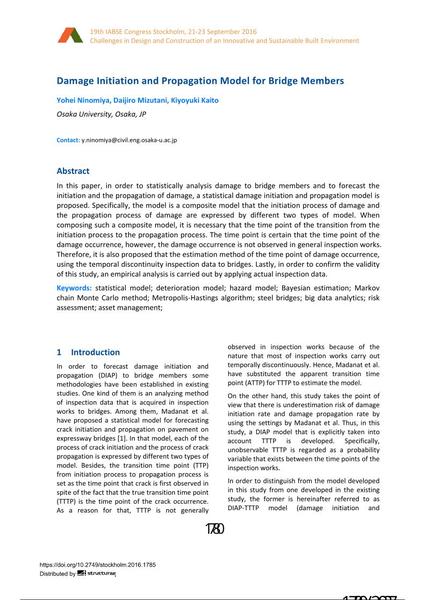Damage Initiation and Propagation Model for Bridge Members

|
|
|||||||||||
Bibliografische Angaben
| Autor(en): |
Yohei Ninomiya
(Osaka University, Osaka, JP)
Daijiro Mizutani (Osaka University, Osaka, JP) Kiyoyuki Kaito (Osaka University, Osaka, JP) |
||||
|---|---|---|---|---|---|
| Medium: | Tagungsbeitrag | ||||
| Sprache(n): | Englisch | ||||
| Tagung: | IABSE Congress: Challenges in Design and Construction of an Innovative and Sustainable Built Environment, Stockholm, Sweden, 21-23 September 2016 | ||||
| Veröffentlicht in: | IABSE Congress Stockholm, 2016 | ||||
|
|||||
| Seite(n): | 1780-1787 | ||||
| Anzahl der Seiten (im PDF): | 8 | ||||
| Jahr: | 2016 | ||||
| DOI: | 10.2749/stockholm.2016.1785 | ||||
| Abstrakt: |
In this paper, in order to statistically analysis damage to bridge members and to forecast the initiation and the propagation of damage, a statistical damage initiation and propagation model is proposed. Specifically, the model is a composite model that the initiation process of damage and the propagation process of damage are expressed by different two types of model. When composing such a composite model, it is necessary that the time point of the transition from the initiation process to the propagation process. The time point is certain that the time point of the damage occurrence, however, the damage occurrence is not observed in general inspection works. Therefore, it is also proposed that the estimation method of the time point of damage occurrence, using the temporal discontinuity inspection data to bridges. Lastly, in order to confirm the validity of this study, an empirical analysis is carried out by applying actual inspection data. |
||||
| Stichwörter: |
statistisches Modell Risikobewertung Stahlbrücken
|
||||
